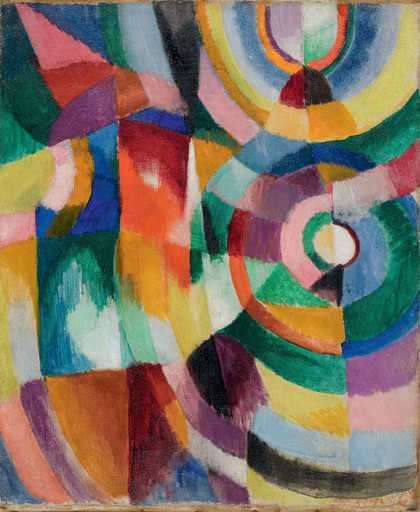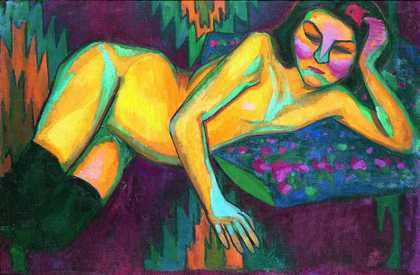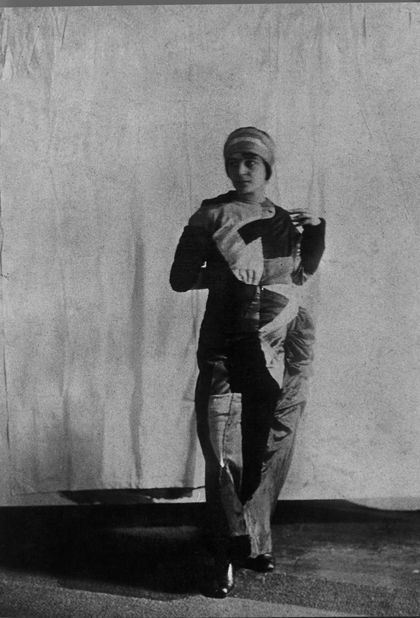
Sonia Delaunay Electric Prisms 1913 Davis Museum at Wellesley College, Wellesley, MA, Gift of Mr. Theodore Racoosin
© Pracusa 2014083
I met Sonia Delaunay in the late 1960s when Charles Slatkin, a New York gallerist working with tapestries, came to Paris and asked me to accompany him to a meeting with her, as I spoke French. He wanted to buy some of her gouaches from which to make tapestries. I was delighted to go to her large apartment-studio in the 7th arrondissement. I remember her strong presence when she walked into the room – many Ukranian and Russian women have this powerful aura. What immediately struck me was her shrewdness in the way she was negotiating with the dealer. She appeared multi-talented and had an innate ability to market herself and her work that outdistanced any others around the table.
She was a great asset to her husband Robert Delaunay, and we see how his legacy benefited from her vigilance and input. I have the impression that he overshadowed her merely because he was French and a man. In a recent conversation with two French curators I asked the question: ‘Do you think Robert would have done for Sonia what Sonia did for him – if she had died first?’ There was a deathly silence.
It was extremely inspiring to see a woman working with different disciplines – design, painting, textiles. Her reach was enviable. She was part of a tradition of Russian artists such as Liubov Popova and Varvara Stepanova who combined their knowledge of artisanal techniques with their beaux arts training as a way into the world of fashion. And her designs were outstanding. Look at her marvellous knitted bathing suit or patterned overcoat. If you were to walk into an exhibition and saw a woman dressed in that overcoat, she would steal the show.

Sonia Delaunay
Yellow Nude 1908
Musée des Beaux-Arts de Nantes, Nantes
© Pracusa 2014083
Of course in Paris there were other powerful women designers, such as Madame Grès and Coco Chanel. The former’s designs were very sinuous, and Chanel was cutting back to the bone, whereas Sonia seemed to work on a frontal level. I like the powerful geometry of her designs – encasing a curvilinear body, contained and boxed-in like a walking cubist form. They were definitely not cute; they were harsh designs for husky women. I would have loved to see Gertrude Stein dressed in Sonia Delaunay’s clothes.
I admire her early paintings, especially Yellow Nude from 1908. You can’t really tell if the reclining figure that she has painted is male or female. It is coy, seductive, androgynous, as if she didn’t seem to care whether it was either. And if you read her biography, you find that she had a rather open attitude to sexuality – her first marriage was to a homosexual, and later to Robert. It was probably part of her shrewdness too – in making things work for her.

Sonia Delaunay in Simultaneous dress, c1913
© Bibliothèque Kandinsky
Has her work influenced mine? I came out of the Josef Albers camp, where colour was more magical and less obvious than Delaunay. I tend to go for unexpected nuanced colour combinations. So I would say not, but her workaholic attitude and willingness to experiment and try out things in different ways has. She was fearless, so why shouldn’t we be fearless. And I am very influenced by her teamwork – the big mural paintings she did for Palais de l’Air in 1937. I love those. She would have had teams of people working on them. They are such powerful works, so present and timeless. They send out a strong message – pronouncing a new world. They are not domestic works done at the easel. They are out in space. They are universal.
